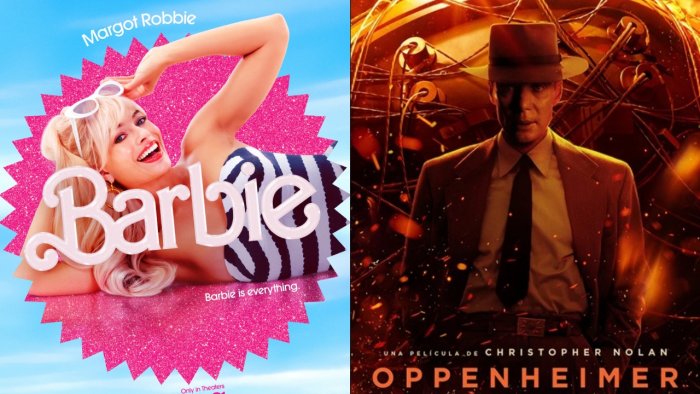
It’s a matchup for the ages, up there with Ali vs. Frazier, the Hatfields vs. the McCoys and Athens vs. Sparta.
Well, let’s not get carried away.
But it is fair to say that with Barbie vs Oppenheimer, Hollywood has not captured the popular imagination in this way for quite some time. On Thursday night, the two wildly incongruous Hollywood megamovies arrive in theaters after weeks of internet meme-ification and questionable marketing tie-ins. (We’re looking at you, Barbie-inspired Burger King sandwich topped with what looks like chewed bubble gum.) Together, the movies could generate the biggest crowds at North American multiplexes in four years, numbers not seen since before the pandemic, box office prognosticators said.
Read | Why IMAX is the holy grail for cinephiles
“Barbie and Oppenheimer are basically the perfect frenemies at the box office this weekend,” said Dave Karger, the Turner Classic Movies host. “Yes, they’re technically competitors, but they’re largely going after different audiences, and the Barbenheimer hype seems only to be helping both films.”
Greta Gerwig’s candy-coated Barbie, which cost an estimated $145 million to make, not including marketing costs, has the potential to earn $100 million in the United States and Canada through Sunday, according to analysts who track audience interest and use complex formulas to forecast box office performance. Christopher Nolan’s weighty Oppenheimer, which cost at least $100 million before marketing, is looking at around $50 million in domestic ticket sales over the same period.
Warner Bros., citing presales of about $30 million, said it was expecting closer to $75 million in weekend ticket sales for Barbie. (Studios try their darnedest to downplay expectations.) The studio has booked the PG-13 comedy onto about 4,200 screens in North America.
Universal Pictures, the studio behind Oppenheimer, an R-rated historical drama about the making of the atomic bomb, declined to comment. It will unfurl Nolan’s film on about 3,600 domestic screens.
Barbie has a run time of just under two hours. Oppenheimer stretches three, limiting the number of screenings that theaters can squeeze into the weekend. Oppenheimer, however, has the benefit of playing on most of North America’s large-format screens, which come with a ticket surcharge of up to $12 in New York. IMAX is devoting its entire footprint to Nolan’s opus for the next three weeks (to the chagrin of Tom Cruise, who hoped his “Mission: Impossible — Dead Reckoning Part One” would continue to play on some of those screens after opening last week).
AMC Entertainment, the world’s largest cinema chain, said on Monday that more than 40,000 people had purchased tickets to see Barbie and Oppenheimer as a double feature, up from 20,000 last week.
Hollywood urgently needs a weekend that exceeds — or even meets — expectations. This was the year when moviegoing was finally supposed to bounce back from the pandemic, which closed many theaters for months on end and sped the growth of streaming services in homes. At last, cinemas would reclaim a position of cultural urgency. But ticket sales in the United States and Canada for the year to date (about $5 billion) are down by about 20% from the same period in 2019, according to Comscore, which compiles box office data.
Blips of hope, including strong sales for the innovative “Spider-Man: Across the Spider-Verse” and the hyper-violent “John Wick: Chapter 4,” have been blotted out by disappointing results for expensive franchise films including “Indiana Jones and the Dial of Destiny,” “Ant-Man and the Wasp: Quantumania,” “Shazam! Fury of the Gods” and “Fast X.” The latest “Mission: Impossible” film arrived last weekend to solid results, but below what Hollywood had been expecting.
Ticket buyers seem to be tiring of new installments in decades-old franchises. What is succeeding? For the most part, characters that have not been onscreen in recent memory (“The Super Mario Bros. Movie”), new chapters in series that are not as well worn (Creed III) and movies that cater to audiences ignored by Hollywood (“Sound of Freedom,” which has been promoted by the political right).
For all of her world domination, Barbie has never before had her own big-budget movie. Oppenheimer is based on the 2005 biography “American Prometheus” by Kai Bird and Martin J. Sherwin.
“Both studios went all-in on original films, directed by notable auteurs with an interest in pushing the envelope,” said Paul Dergarabedian, a senior Comscore analyst. “These are not the tried-and-true safe bets that are the hallmark of the summer movie season.”
Barbie has major movie stars — Margot Robbie and Ryan Gosling — while Oppenheimer cast the lesser-known Cillian Murphy in the title role. Barbie is aimed at women, while Oppenheimer has the edge with men. One represents what many cinephiles loathe about Hollywood: movies based on toys. The other was written and directed by one of Hollywood’s most serious cinephiles.
Comedy against drama. The brightest side of human imagination vs. the darkest. Creating worlds, destroying worlds. The contrasts are irresistible.
While rare, such box-office matchups are not without precedent. Just ask Nolan: In July 2008, his sinister Batman movie The Dark Knight (Warner Bros.) arrived head-to-head with Universal’s silly, sun-drenched “Mamma Mia!” His was No. 1 that weekend, but both movies became runaway hits.
Deccan Herald News now on Telegram - Click here to subscribe
Follow us on Facebook | Twitter | Dailymotion | YouTube













